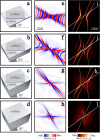Unidirectional ray polaritons in twisted asymmetric stacks
- PMID: 39426947
- PMCID: PMC11490623
- DOI: 10.1038/s41467-024-52750-3
Unidirectional ray polaritons in twisted asymmetric stacks
Abstract
The vast repository of van der Waals (vdW) materials supporting polaritons offers numerous possibilities to tailor electromagnetic waves at the nanoscale. The development of twistoptics-the modulation of the optical properties by twisting stacks of vdW materials-enables directional propagation of phonon polaritons (PhPs) along a single spatial direction, known as canalization. Here we demonstrate a complementary type of directional propagation of polaritons by reporting the visualization of unidirectional ray polaritons (URPs). They arise naturally in twisted hyperbolic stacks with very different thicknesses of their constituents, demonstrated for homostructures of -MoO3 and heterostructures of -MoO3 and -Ga2O3. Importantly, their ray-like propagation, characterized by large momenta and constant phase, is tunable by both the twist angle and the illumination frequency. Apart from their fundamental importance, our findings introduce twisted asymmetric stacks as efficient platforms for nanoscale directional polariton propagation, opening the door for applications in nanoimaging, (bio)-sensing, or polaritonic thermal management.
© 2024. The Author(s).
Conflict of interest statement
The authors declare no competing interests.
Figures





References
-
- Basov, D. N. et al. Polaritons in van der Waals materials. Science354, aag1992 (2016). - PubMed
-
- Low, T. et al. Polaritons in layered two-dimensional materials. Nat. Mater.16, 182–194 (2017). - PubMed
-
- Caldwell, J. D. et al. Low-loss, infrared and terahertz nanophotonics using surface phonon polaritons. Nanophotonics4, 44–68 (2015).
-
- He, M. et al. Ultrahigh-resolution, label-free hyperlens imaging in the Mid-IR. Nano Lett.21, 7921–7928 (2021). - PubMed
LinkOut - more resources
Full Text Sources

